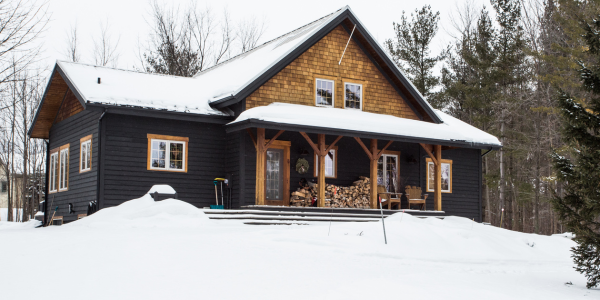Why Winterizing Your Home Matters
As winter approaches, preparing your home isn’t just about keeping it cozy; it’s about protecting one of your largest investments. Winterizing can save you from unexpected (and expensive) repairs, lower energy bills, and keep your space comfortable all season long. Think of it as setting up a shield against the elements. Taking these steps now means less stress when the temperatures drop, and you’re ready to enjoy the warmth without worrying about costly home damage.
Preparing the Exterior: First Line of Defense
Winter’s bite is felt most on your home’s exterior, so start here to ensure your walls, windows, and pipes are ready to stand up to the cold. For the exterior, think of yourself as “sealing the envelope” around your home, keeping cold air out and warm air in.
Check around doors and windows for any gaps or cracks, as these are prime spots for drafts to sneak through. By sealing up these areas with weatherproof caulk or sealant, you’ll be surprised at how much more comfortable (and energy-efficient) your home will feel. Don’t forget your outdoor pipes! Unprotected pipes are at risk of freezing and bursting, which can lead to water damage and costly repairs. Adding insulation sleeves or even simple pipe wraps can make all the difference. Finally, store away any outdoor furniture and gardening tools. Clean them off, cover them, and store them in a safe place to prevent wear and tear from the elements.
Interior Preparations: Keep the Warmth Inside
With the outside secured, it’s time to turn your attention indoors. One of the biggest game-changers for winter comfort is your heating system, so give it some attention before it’s running non-stop. Scheduling a quick HVAC maintenance checkup can ensure your system is working at peak efficiency, saving you both money and potential headaches if things go south in the middle of a snowstorm.
Another must-do is insulating any drafty areas—especially in attics, basements, and around windows. Heat naturally rises, which means an uninsulated attic can be a major source of heat loss. By insulating this space, you’re keeping the warm air where it belongs. In rooms that still feel drafty, consider adding weatherstripping around doors and windows. This simple update keeps the cold air out and makes a noticeable difference in warmth, all while reducing heating costs.
Winter Plumbing Protection: A Checklist
Winter-proofing your plumbing is one area where a checklist really helps to keep things efficient and organized. Here are some key steps to prevent frozen pipes and ensure your water flows smoothly all season long:
- Drain Exterior Faucets and Hoses: Disconnect and drain all hoses, then shut off water to exterior faucets if possible. This avoids water left in pipes from freezing and causing damage.
- Insulate Exposed Interior Pipes: Pipes located in colder areas, like basements and garages, are more likely to freeze. Cover these with pipe insulation for added protection.
- Install a Smart Thermostat: If you don’t already have one, a smart thermostat can make a noticeable difference in energy costs by automatically adjusting to your schedule and needs.
By following these plumbing steps, you’re protecting your home from costly winter water damage and ensuring smooth operations through the season.
Energy Efficiency Tips for Winter
Making your home more energy-efficient isn’t just about saving a few bucks; it’s about comfort and sustainability. For example, switching to LED lights for your holiday decorations and everyday needs is a quick upgrade that’s friendlier on your wallet and lasts longer. Another trick to keep things toasty without increasing the heat is to use draft stoppers and thermal curtains, especially on windows facing the north or those prone to drafts. These additions block the cold air from creeping in and help keep your indoor temperature stable.
To make the most of the sunlight, open curtains during the day to let in natural warmth. In the evening, close them up to retain that heat. These small habits go a long way toward reducing your heating needs and cutting down on energy use.
Getting Equipment Ready for Winter
Indiana winters can be unpredictable, so now’s the time to ensure all your winter equipment is in good working order. Check your snowblower to ensure it starts easily, and stock up on essentials like ice melt or sand for slick driveways and sidewalks. A quick tune-up now will save you time and hassle when the first snow hits.
If you haven’t done so already, clear out summer equipment and give it a proper clean and store—this keeps it in good shape for spring. Winter maintenance doesn’t have to be a hassle; a few quick checks now keep everything running smoothly when it’s needed most.
Common Winterization Mistakes to Avoid
There are some common missteps that can turn winterizing your home into a more complicated (or costly) process if overlooked. One common issue is ignoring small repairs before they get worse. For instance, cracks around windows or a small leak in the roof may not seem urgent, but they can quickly worsen in harsh weather. Take the time to address these minor repairs now to prevent them from becoming bigger problems.
Skipping regular HVAC maintenance is another mistake. The last thing you want is for your heater to break down during a cold snap because of something that could have been avoided with a quick check. Lastly, don’t overlook indoor humidity. Winter air can be incredibly dry, which leads to static electricity, uncomfortable skin, and even damage to wood furniture. Running a humidifier helps keep indoor air comfortable and balanced.
Final Checklist for Winterizing Your Home
Once you’ve gone through the main areas of winter prep, here’s a quick checklist to confirm everything is winter-ready:
- Check for drafts around doors and windows and seal with weatherproof caulk.
- Clean and store outdoor furniture and equipment.
- Ensure your heating system is serviced and in top shape.
- Insulate attics, basements, and exposed interior pipes.
- Test smoke and carbon monoxide detectors for safety.
- Trim trees and bushes near your home to prevent damage from ice and snow.
With everything checked off, you can settle into the colder months with peace of mind, knowing your home is prepped and protected.
Lockstep Realty: Here to Help You Prepare for Winter
Winterizing can feel like a big project, but it’s worth it for the comfort and safety it brings. If you’re looking for trusted professionals or advice tailored to Indiana winters, Lockstep Realty, part of eXp Realty, is here to help. Our team understands the unique needs of homeowners in Central Indiana and can connect you with local resources or provide more tips for keeping your home in top shape year-round.
FAQs
- How often should I winterize my home?
- Ideally, once every fall to prepare for winter, with a few safety checks like smoke detectors done twice a year.
- What’s the best way to prevent pipes from freezing?
- Insulate any exposed pipes, maintain a low but consistent heat indoors, and leave cabinets open where pipes run along exterior walls.
- Is it expensive to prepare a home for winter?
- Winterizing can be affordable, especially since many tasks are DIY-friendly and save you money in the long run.
- Which areas should I prioritize?
- Focus on insulating attics, sealing windows and doors, servicing your HVAC, and winter-proofing plumbing.
- Can I hire someone to handle winterizing for me?
- Yes, many contractors specialize in winterization, covering everything from HVAC to plumbing and insulation.



